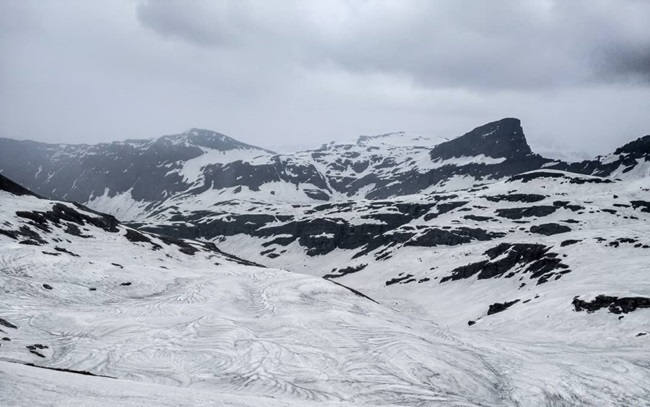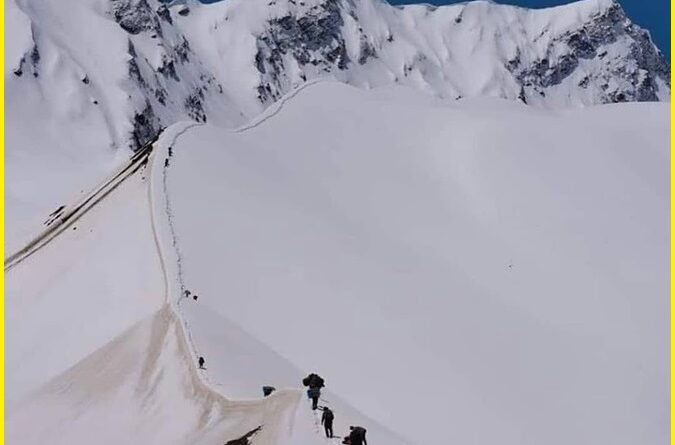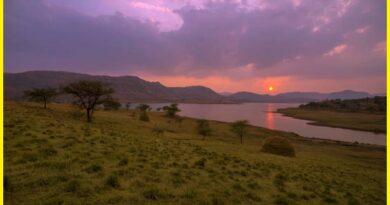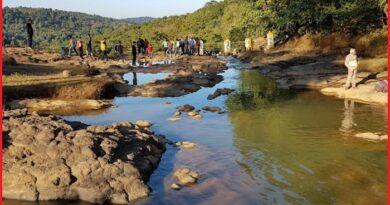“Peak Pursuits- Bali Pass Trekking Adventure”
Bali Pass Trek
The Bali Pass trek is a popular trekking route in the Indian state of Uttarakhand, in the Garhwal region of the Himalayas. It is considered a challenging trek, suitable for experienced trekkers due to its high altitude and rugged terrain. The trek starts from Sankri village, which is around 200 kilometers from Dehradun, the capital city of Uttarakhand. The trail passes through picturesque villages, dense forests, alpine meadows, and high-altitude passes before concluding in the village of Yamunotri.
The trek typically takes around 7-9 days to complete, depending on the route chosen and the pace of the trekker. The highest point of the trek is the Bali Pass itself, which stands at an altitude of approximately 4,800 meters (15,748 feet) above sea level. Trekkers need to be well-acclimatized to handle the high altitude.
Difficulty
The Bali Pass trek is considered moderately to highly difficult due to its steep ascents, rocky terrain, and high altitude. Trekkers should have prior trekking experience and a good level of physical fitness to undertake this trek. Trekkers need to obtain permits from the forest department and sometimes from other authorities depending on the current regulations. It’s important to check the latest permit requirements before embarking on the trek.
Scenery
The trek offers stunning views of snow-capped peaks, including Swargarohini, Bandarpoonch, and Kalanag. Trekkers also get to witness the beauty of alpine meadows, glaciers, and pristine mountain lakes along the route.
Bali Pass Trek Best Time
The best time to undertake the Bali Pass trek is during the summer months from May to June and the post-monsoon months of September to October.
Summer (May to June)
During this time, the weather is generally favorable for trekking, with clear skies and warmer temperatures in the Himalayan region. The snow at higher altitudes starts melting, making the trekking trails more accessible.
The alpine meadows and valleys are in full bloom, offering stunning views of colorful wildflowers and lush greenery. Trekkers can enjoy longer daylight hours, allowing for more comfortable and leisurely trekking experiences.
Also Read- Traversing the Trails-Har Ki Dun Trek Adventure
Post-Monsoon (September to October)
After the monsoon season, the weather becomes relatively stable, with clear skies and minimal rainfall. The trails are usually less crowded compared to the peak summer season, offering a more serene trekking experience.
The landscapes are still vibrant with greenery, and the weather is cooler than the summer months, making trekking more comfortable. The views of the surrounding snow-capped peaks are apparent during this time, providing excellent photographic opportunities.
It’s important to note that weather conditions in the Himalayas can be unpredictable, and it’s always advisable to check the local weather forecast before embarking on the trek.

Bali Pass Trek Itinerary
Here’s a sample itinerary for the Bali Pass trek, which typically takes around 7-9 days to complete. This itinerary assumes that you start from Sankri village and end in Yamunotri village. Please note that actual itineraries may vary depending on factors such as weather conditions, trekking pace, and individual preferences.
Day 1: Sankri to Taluka (Drive)
- Start your journey from Sankri and drive to Taluka, which is the starting point of the trek.
- Taluka is a small village located about 12 kilometers away from Sankri.
- Spend the night in Taluka, acclimatizing to the altitude.
Day 2: Taluka to Seema (Trek)
- Begin your trek from Taluka and hike to Seema (also known as Osla).
- The trail passes through dense forests and alongside the Supin River.
- Seema is a picturesque village with a few guesthouses where you can spend the night.
Day 3: Seema to Har-ki-Dun
- Continue trekking from Seema to Har-ki-Dun, which is a beautiful valley known for its meadows and views of snow-capped peaks.
- The trail involves a gradual ascent, and you’ll pass through scenic landscapes.
- Har-ki-Dun is a popular camping site, and you’ll spend the night here.
Day 4: Har-ki-Dun to Ruinsara Tal
- Leave Har-ki-Dun and trek to Ruinsara Tal, a stunning high-altitude lake surrounded by mountains.
- The trail climbs steadily, offering panoramic views of the surrounding peaks.
- Set up camp near Ruinsara Tal and spend the night by the lake.
Day 5: Acclimatization Day at Ruinsara Tal
- Take a rest day at Ruinsara Tal for acclimatization and exploration.
- You can hike around the lake or relax and enjoy the beautiful surroundings.
- Use this day to recharge and prepare for the challenging sections of the trek ahead.
Day 6: Ruinsara Tal to Bali Pass Base Camp
- Begin your ascent towards the Bali Pass Base Camp.
- The trail involves steep climbs and rocky terrain as you make your way to higher altitudes.
- Camp at the base of the Bali Pass, preparing for the pass crossing the next day.
Day 7: Bali Pass Base Camp to Lower Dhamni
- Today is the most challenging day of the trek as you cross the Bali Pass.
- Start early in the morning to take advantage of good weather conditions.
- After crossing the pass, descend to Lower Dhamni for the night.
- The descent involves steep sections, so proceed with caution.
Day 8: Lower Dhamni to Yamunotri
- Continue descending from Lower Dhamni towards Yamunotri.
- The trail passes through forests and meadows, offering scenic views along the way.
- Reach Yamunotri, where the trek concludes.
- You can visit the famous Yamunotri temple before resting for the night.
Day 9: Yamunotri to Dehradun (Drive)
- Take a shared jeep or bus from Yamunotri to Dehradun, where you can catch your onward journey.
This itinerary provides a general outline of the Bali Pass trek, but keep in mind that it can be adjusted based on your preferences, trekking pace, and any unforeseen circumstances that may arise during the trek. It’s essential to be flexible and prepared for changes in the itinerary as needed.
Bali pass trek India hikes
Indiahikes is a well-known trekking organization that offers guided treks to various destinations in India, including the Bali Pass trek. If you’re considering doing the Bali Pass trek with Indiahikes, they typically provide comprehensive trekking packages that include guides, permits, accommodation, meals, and other necessary arrangements. Here’s an outline of what you might expect from an Indiahikes’ trek to Bali Pass:
Pre-Trek Preparation
Indiahikes will provide detailed information about the Bali Pass trek, including the itinerary, packing list, and fitness requirements.
They may also offer guidance on pre-trek training and preparation to ensure participants are adequately prepared for the challenges of the trek.
On-Trek Experience
Experienced trek leaders and support staff will accompany the group throughout the trek.
Indiahikes’ team will handle logistics such as permits, accommodation arrangements (camping or guesthouses), and meals.
They will ensure safety protocols are followed and provide assistance during the trek.
The trekking pace and schedule will be organized to maximize enjoyment and acclimatization while covering the designated route.
Post-Trek Support
After completing the trek, Indiahikes may offer debriefing sessions and feedback opportunities to participants.
They might also provide resources or recommendations for post-trek activities or further regional adventures.
What to Expect
Professional and knowledgeable trek leaders who are familiar with the Bali Pass route and its challenges.
Well-organized logistics, including transportation, accommodation, and meals, to ensure a smooth trekking experience. Opportunities to connect with fellow trekkers and immerse yourself in the natural beauty and culture of the Himalayan region.
Safety and support throughout the trek, with trained staff equipped to handle emergencies or unexpected situations.
If you’re interested in joining an Indiahikes trek to Bali Pass or any other destination, you can visit their website or get in touch with their team for more information about upcoming treks, availability, and booking procedures.

Bali Pass Trek Package
Many travel agencies organize Trek packages for the Bali Pass trek like Indiahikes or other tour operators. The general idea of what a typical trekking package for the Bali Pass trek might include-
Trekking Itinerary: A detailed day-by-day itinerary outlining the trekking route, camping locations, and major highlights along the way.
Experienced Guides and Support Staff: Trained trek leaders and support staff who are familiar with the Bali Pass route and are responsible for guiding the group, ensuring safety, and providing assistance as needed.
Permits and Permissions: Arrangements for necessary permits and permissions required for the trek, including forest permits and any other regulatory approvals.
Accommodation: Accommodation arrangements for the entire duration of the trek, which may include camping at designated campsites or staying in guesthouses/homestays in local villages along the route.
Meals: Nutritious meals are provided throughout the trek, including breakfast, lunch, and dinner. Meals are usually prepared by the support staff and are designed to provide energy and sustenance for trekking activities.
Transportation: Transportation arrangements from the nearest city or town to the trekking starting point and back. This may include private vehicles, shared jeeps, or buses depending on the accessibility of the trailhead.
It’s important to carefully review the inclusions and exclusions of any trekking package before booking to ensure that it meets your preferences, requirements, and budget. Additionally, pricing for trekking packages can vary depending on factors such as the duration of the trek, the level of services provided, and the reputation of the trekking operator.
How to reach Bali Pass Trek
Reaching the starting point of the Bali Pass trek involves several steps, typically starting from Dehradun, Uttarakhand, India. Here’s a general guide on how to reach the trek starting point:
The nearest airport is the Jolly Grant Airport in Dehradun, which has regular flights from major cities like Delhi. Dehradun is also well-connected to major cities across India by railway. Dehradun is accessible by road from nearby cities and towns. You can either take a bus or hire a taxi/private vehicle to reach Dehradun.
Travel from Dehradun to Sankri
Sankri is the base village for the Bali Pass trek. It’s located approximately 200 kilometers from Dehradun.
By Road- From Dehradun, you can take a bus or hire a taxi to reach Sankri. The journey takes around 8-10 hours by road, depending on road conditions and traffic.
Shared jeeps and buses are available from Dehradun to Sankri. These are often found at the Dehradun bus stand or can be arranged through local travel operators.
Commence the Trek from Sankri
Once you reach Sankri, you’ll begin your trekking journey towards Bali Pass. The trek typically starts from Taluka village, which is a short distance away from Sankri. You can either walk from Sankri to Taluka (around 12 kilometers) or arrange local transportation if available.



